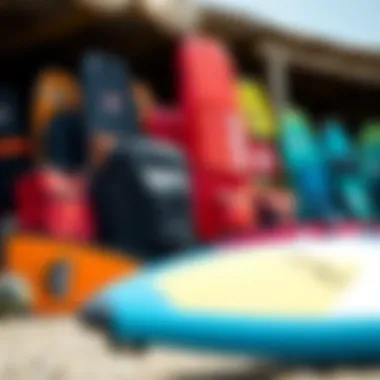Essential Guide to Kitesurf Board Bags: Protection & Tips


Intro
Kitesurfing is not just a sport; it's a lifestyle for many. However, to fully embrace this vibrant activity, the right gear is essential, and the kitesurf board bag is undoubtedly among the most critical pieces of equipment. These bags serve more than just a way to transport your board—they are a protective shell that guards your investment against the elements when you're on the go or during storage.
The topic of kitesurf board bags deserves a thorough examination. Protecting your board from scratches, dings, and environment-related wear-and-tear is paramount. Having a solid bag saves you from costly repairs and maintains the board's resale value. Moreover, the process of picking the right board bag entails understanding aspects such as size, material, and design. Each of these factors plays a vital role in ensuring that your gear remains in optimal condition.
In this guide, we will explore the various nuances of kitesurf board bags, touching on essential features to consider, maintenance tips, and even product recommendations. This exploration aims to equip both the novice and seasoned kitesurfer with the know-how necessary to make informed selections regarding board bags. Let's dive deeper into this critical aspect of kitesurfing.
Understanding Kitesurf Board Bags
When it comes to kitesurfing, it’s easy to get caught up in the thrill of riding the waves, the rush of wind in your face. However, the importance of having the right gear cannot be overstated. Kitesurf board bags are a crucial component of kitesurfing equipment, serving as protective shells for your board, whether it's during travel, storage, or just keeping it safe when it’s not in use.
Kitesurf board bags not only safeguard your board from scratches, dings, and potential water damage, but they also make transportation a breeze. With a solid board bag, you can trust that your investment is protected, which allows you to focus on what's truly important—the ride. In this section, we dive into the essential aspects that define kitesurf board bags, starting with their definition and purpose.
Definition and Purpose
A kitesurf board bag is generally a padded fabric case designed specifically to accommodate kitesurf boards. It comes in various sizes and styles to suit different types of boards and personal preferences. The primary purpose of a kitesurf board bag is to protect the board from external elements, such as bumps during travel and exposure to adverse weather conditions.
In addition to protection, a well-constructed bag helps with organization and portability. Many kitesurf board bags include extra compartments for accessories—think straps, fins, and even the kite. This feature can save time and energy, especially when trying to gather all your gear for a spontaneous session at the beach.
It's as if the bag becomes a trusted companion on your kitesurfing adventures, helping you keep everything together. A good bag can vastly improve the ease of your travels, allowing you to seamlessly transition from your home to the waves without any headaches or hassles.
Historical Context
The inception of kitesurf board bags can be traced back to the early days of kitesurfing itself, evolving from basic protective wraps to specialized gear that we see today. In the early 1990s, kitesurfing began to gain traction, and as it did, the need for proper protection for equipment became apparent. Initially, kitesurfers relied on simple padded covers that barely sufficed.
However, as technology advanced, so did the designs and materials used in these bags. Today, you’ll find high-quality kitesurf board bags made from durable, water-resistant materials that are engineered to withstand rigorous conditions.
Over the years, manufacturers have taken feedback from kitesurfers into account, leading to innovations such as specialized padding, waterproofing, and even lightweight designs. The evolution of kitesurf board bags illustrates how a community’s needs shape the development of essential gear. It showcases the dynamic relationship between the sport itself and the equipment designed for it.
"The journey of a kitesurfer begins long before they hit the water. It starts with the gear that carries their passion."
In summary, understanding kitesurf board bags means recognizing their critical role in protecting and transporting your board, ensuring you have everything you need for a successful day on the water. As we proceed through this guide, you'll uncover the vital aspects to consider when selecting the right bag for your needs.
Key Features of Kitesurf Board Bags
When it comes to kitesurfing, selecting the right board bag can make all the difference. The key features of kitesurf board bags are crucial for ensuring the safety and portability of your valuable equipment. Each feature plays a role in protecting your board from damage, facilitating easy transport, and offering convenience during storage. Not considering these aspects may lead to unnecessary wear and tear, or, worse yet, damage to your gear.
Material Composition
Durability Considerations
Durability is a non-negotiable aspect when it comes to kitesurf board bags. A bag made from strong, high-quality materials can withstand the rigors of travel and transport. This durability is often derived from specialized fabrics like 600D polyester or nylon, which are resistant to tears and abrasions. A durable board bag can save you from unexpected costs associated with repairs or replacements.
However, while durability is vital, it's essential to balance it with weight, as heavier materials might not be portable.
Water Resistance Features
A good kitesurf board bag should offer water resistance. Water can damage not just the board but also other gear packed alongside it. Many bags integrate waterproof materials, ensuring that if you find yourself caught in the rain, or splashed by waves, everything inside remains dry. This feature is particularly important for those regularly sailing in unpredictable weather conditions.
Not all water-resistant bags provide full waterproofing, so checking ratings and reviews can be helpful.


Weight and Portability
The weight and portability of a board bag can greatly affect the travel experience. A lighter bag makes it easier to carry to the launch site or airport. Features like padded straps can enhance this experience, providing comfort during transit. Lightweight materials are typically used, but you must also ensure they do not compromise protection. Sometimes, the lightest bags may skimp on padding, which could expose your gear to impact.
Padding and Protection
Types of Padding
The various types of padding can determine how well your board is protected. High-density foam, molded padding, and soft padding each offer different levels of protection. High-density foam, for example, provides robust protection against hard impacts but can make the bag bulkier. On the other hand, soft padding is great for minor bumps and scratches, though might not withstand serious falls. Choosing the right type of padding will depend on how rough you expect your travels to be.
Location of Padding
Location matters just as much as the type of padding used. Strategically placed padding ensures that the most vulnerable areas of your board are shielded. Many bags come with additional reinforcement around the nose and tail areas. This targeted design can significantly enhance the lifespan of your board, preventing common types of damage that occur during handling or transport.
Impact Resistance
Impact resistance is a critical feature for any kitesurf board bag. A bag should be designed to absorb shock from falls or impacts with other items. Materials and padding configurations specifically created for impact resistance can minimize damage to your gear. Look for bags that advertise this feature, as it often correlates with higher quality and better performance in the field.
Size and Fit
Board Dimensions
Choosing a bag that fits the dimensions of your board snugly is important. A bag that's too large can allow the board to move around inside, increasing the risk of scratches and damage. Conversely, if the bag is too small, it could compress or bend the board. Measure your board accurately, considering the additional space for any fins or accessories, to ensure the best fit.
Adjustable Straps and Handles
Adjustable straps and handles can contribute greatly to comfort and versatility. A bag with adjustable straps allows you to carry it comfortably, regardless of your height or how you prefer to transport it. Look for options that feature padded straps, as they reduce strain during long carries. Handles at different points give you flexibility in how you haul your gear, making life easier especially when loading your board onto a vehicle.
Compatibility with Other Gear
Finally, consider the compatibility with other gear. An optimal kitesurf board bag should offer sufficient space to store your board along with kites, harnesses, and other accessories. Some bags come equipped with multiple compartments, making organization a breeze. This feature can save you time and offer you peace of mind, knowing that all your kitesurfing essentials are in one place, minimizing the risk of forgetting anything behind.
Selecting the Right Kitesurf Board Bag
Choosing the right kitesurf board bag isn't just a matter of aesthetics; it’s fundamental for kitesurfing enthusiasts who want to ensure their equipment’s safety and longevity. The right bag serves as a protective layer against the elements, whether it be saltwater, sand, or simply the wear and tear of travel. Understanding how to assess personal requirements and budget considerations significantly impacts one's ultimate decision-making process, thereby enhancing the overall kitesurfing experience.
Assessing Your Needs
Travel Requirements
When planning any sort of adventure with kitesurf equipment, understanding travel requirements is crucial. This aspect concerns how you intend to transport your gear, be it via airplane, car, or even cycling to a local beach spot.
A key characteristic of travel requirements is its emphasis on portability. A lot of thought should be paid to the dimensions and weight of the bag, as airlines often have strict rules on baggage size and weight. Bags designed for airline travel usually come with a rugged construction, but they're also generally lighter for ease of handling.
Another unique feature of travel requirements is wheeled options. These bags are especially beneficial for travelers as they make navigation through crowded airports relatively simple. However, they might come with a trade-off in terms of bulkiness when compared to smaller, non-wheeled bags. If you’re considering going on long trips, a wheeled bag can save you from lugging heavy gear around. Not every bag fits on every transport mode, thus why consideration here is paramount to avoid problems down the line.
Storage Space
Next up is understanding storage space, an often underappreciated aspect of selecting a kitesurf board bag. This involves knowing not just how much room the bag provides, but also how you plan to store or pack it when not in use.
The significant characteristic here is versatility. A good kitesurf board bag should have additional compartments for other gear like harnesses, kites, or even your wetsuit. This feature makes it easier to organize equipment, avoiding last-minute scrambles at the beach.
Moreover, bags designed with expandable compartments offer flexibility for those who might want to carry more in varying situations. It’s both a blessing and a curse; while it allows for additional storage, it can also add extra weight when fully packed. In balancing convenience and usability, assessing how much storage space you truly require for your expeditions will lead to a more satisfactory experience.


Budget Considerations
Cost vs. Quality
Diving into budget considerations, the nexus between cost and quality arguably shapes the decision-making process for any kitesurfer. A fundamental aspect worth noting here is that not all high-cost items guarantee superior quality. While generally, higher costs can indicate better materials and durability, it's crucial for buyers to research before splashing out cash.
Opting for trusted brands might offer an assurance of quality; however, this can come at a premium. Exploring lesser-known brands can sometimes net excellent gear at more affordable prices. Yet, there’s a risk that cheaper options may lack physical durability in the long run. The trick is to find a sweet spot—balancing your budgetary constraints with the quality needed to safeguard your gear efficiently.
Long-term Investment
Rounding out the budget considerations is the concept of viewing a kitesurf board bag as a long-term investment. This perspective shifts focus from immediate savings to potential future expenses. A higher upfront cost might seem daunting, but it often pays off over time.
The big characteristic here is longevity. A robust and well-made board bag will provide protection against various elements and potential accidents, reducing the likelihood of having to replace your equipment sooner rather than later. Some models even come with warranties or repair guarantees, providing buyers peace of mind.
A downside to initially higher costs might be compelling, especially to rookie kitesurfers trying to minimize expenses. However, the long-term benefits, such as fewer replacements and better care for your boards, typically justify the investment. Choosing wisely now can save your wallet a lot of pain later.
“Investing in quality gear enhances not only the experience but also ensures safety while enjoying the thrill of kitesurfing.”
Popular Brands of Kitesurf Board Bags
With the rising popularity of kitesurfing, the market has become flooded with a myriad of brands, each vying for the attention of enthusiasts and professionals alike. Navigating through these options can be as tricky as a gusty wind on the water. Understanding the standout brands equips kitesurfers with the insight needed to choose the right board bag. Rather than just choosing a flashy logo or a catchy tagline, knowing the reputation, quality, and unique features of each brand can ensure that you invest in a reliable piece of gear that meets your needs.
Brand Reviews
Brand A Overview
Brand A is known for maintaining high standards in craftsmanship. From stitching to material selection, the attention to detail shines through in their products. One of their key characteristics is the use of high-denier nylon, which not only provides durability but also offers resistance to tears and abrasions. This is particularly beneficial for kitesurfers who travel often. The unique feature that sets Brand A apart is the integrated compression system. This means that their bags can be compacted, minimizing the space they take up when not in use. It’s a clever addition that provides both convenience and functionality, making it a popular choice for many.
Brand B Features
Brand B takes a slightly different approach, focusing on aesthetic appeal alongside functionality. Their bags boast vibrant color combinations and artful designs. However, don’t let the good looks fool you; they come with reinforced padding that ensures boards are well-protected during transport. A notable feature is their ventilation system, which helps avoid moisture build-up and keeps boards dry. This is crucial for preserving the integrity of the board surface and enhancing longevity. While some might find their prices on the higher end, the quality and design can justify the investment for many passionate riders.
Brand Comparison
When discussing Brand C, the conversation often revolves around value for money. They cater to a wide range of budgets without compromising on quality. The key characteristic of Brand C is their focus on lightweight design. They use specialized materials that make their board bags easier to carry around, which can be a game-changer for those lugging gear across distances. Comparing it with the other brands, Brand C doesn’t skimp on protection either, offering customizable padding options that allow users to tweak the level of impact resistance. Although they may lack some of the advanced features of their higher-end counterparts, their balance of affordability and quality doesn’t go unnoticed among recreational kitesurfers.
Knowing these brands and their offerings not only helps in making an informed decision but also enhances the overall kitesurfing experience.
Each of these brands brings something distinct to the table, whether that be high durability, aesthetic appeal, or value. By taking into account their unique properties, a kitesurfer can better match their gear to their personal style and travel needs.
Caring for Your Kitesurf Board Bag
Caring for your kitesurf board bag is just as crucial as the gear it protects. These bags not only shield your board from scratches and dings during transport but also enhance its longevity. Neglecting the upkeep of your board bag can lead to increased wear on your board, so understanding the best practices for maintenance and care is essential. Let's delve into some practical tips for keeping your kitesurf board bag in top-notch shape.
Maintenance Tips
Cleaning Procedures
Cleaning your kitesurf board bag is fundamental to preserving its integrity and functionality. Salt water, sand, and grime can accumulate over time, making it vital to establish a regular cleaning routine. A straightforward way to clean your bag is to rinse it with fresh water after each use, especially if you've been out on the ocean.
The main advantage of this cleaning method is that it prevents salt buildup which can cause corrosion and weaken the material. Utilizing a soft brush can help remove stubborn dirt and sand without damaging the fabric. Additionally, for a deeper clean, using mild soap and warm water can break down more persistent stains.


However, be cautious about washing machine cycles; most kitesurf board bags aren't designed for that. Air drying is recommended to avoid damaging any inner padding or seams. Keeping your bag clean in this way not only prolongs its life but ensures that it serves you well through many sessions on the water.
Storage Practices
Now let’s talk about storage practices. Storing your kitesurf board bag correctly when it’s not in use is key to maintaining its condition. Ideally, your bag should be kept in a cool, dry place out of direct sunlight. Excessive heat can warp the material and degrade the protective features of the bag.
When storing, avoid compressing it too tightly or folding it in a way that could damage the structure. Using a closet or an organized area can help keep it protected. A unique feature of proper storage is that it prevents moisture buildup, which can foster mold and mildew, especially in environments with high humidity.
Furthermore, consider investing in a moisture-absorbing product to place inside the bag. This small, proactive measure can save you a hefty repair bill down the line by keeping moisture at bay. All in all, proper storage practices help ensure your kitesurf board bag is ready to go at a moment's notice.
Repairs and Upkeep
Identifying Wear and Tear
Regularly inspecting your kitesurf board bag for wear and tear can save you both time and money. Common signs include frayed straps, fading colors, or cracks in the seams. Identifying these issues early on allows for timely repairs, preventing further damage.
A beneficial characteristic of regularly monitoring your bag is that it keeps you informed about its condition, allowing you to maintain optimal protection for your board. For instance, if you notice stitching that is coming undone, addressing it right away is crucial. This proactive approach ensures that your bag performs well, providing the necessary safeguard for your board during travels.
Moreover, understanding the materials used in your board bag can help you determine how sensitive they are to wear. Some fabrics offer more resilience than others, and having this knowledge can guide your expectations regarding longevity and care.
DIY Repairs
If you find minor issues with your kitesurf board bag, don’t fret; a little DIY repair work can go a long way. Sewing a loose strap or patching a small tear can extend the life of your bag significantly. This practice not only saves you from the hassle of searching for a new bag but can also foster a deeper connection with your gear.
One key feature of DIY repairs is the sense of accomplishment that comes with them. Knowing that you’ve fixed something yourself can boost your confidence and ensure that your gear is in a trustworthy state. However, be cautious; if the damage is extensive, seeking professional help might be the best course of action to maintain the bag's integrity.
In summary, taking care of your kitesurf board bag involves regular maintenance through cleaning, proper storage, and timely repairs. By keeping an eye on its condition and adopting a hands-on approach where possible, you can ensure that your board bag remains a reliable companion on all your kitesurfing adventures.
Kitesurf Board Bag Trends
Kitesurf board bags have seen significant evolution over the years, and today's trends highlight a blend of functionality and sustainability. As kitesurfing enthusiasts increasingly embrace the blend of performance and environmental responsibility, these trends shed light on what modern board bags must offer. Not just mere carriers, board bags are now considered integral to the kitesurfing experience for protection, ease of transport, and aesthetic appeal.
Innovations in Design
Eco-friendly Materials
The talk of the town amongst kitesurfers is eco-friendly materials. This trend represents a significant shift in how products are crafted, with many brands now opting for sustainable options. Notably, materials like recycled polyester and organic cotton are being used for kitesurf board bags. The key characteristic of these materials lies in their reduced environmental impact, making them a thoughtful choice for conscientious riders.
One unique feature of eco-friendly materials is their production process, often involving less energy and water than conventional materials. This characteristic does not just help in reducing carbon footprint; it aligns with the global push for sustainability. However, while these materials offer benefits such as reduced environmental harm, they may sometimes fall short in durability and water resistance compared to traditional options. Thus, weighing the pros and cons becomes essential for buyers focused on sustainability without compromising quality.
Smart Technology Integration
Another rising trend is smart technology integration in kitesurf board bags. As technology becomes more commonplace in sports gear, the inclusion of features such as GPS tracking or temperature regulation systems has gained traction. This innovation serves to enhance both security and convenience for kitesurfers worldwide. Imagine being able to locate your board bag using a smartphone app; it’s a game changer for those who travel frequently.
The key attraction of smart technology lies in its added functionalities that directly benefit users. For instance, a tracking system can prevent the headache of lost luggage during travel. However, with added technology comes added costs. Some riders might find the pricing of tech-integrated bags to stretch their budget a tad thinner. When investing, individuals must balance the allure of cutting-edge features with practical needs.
Market Trends
Consumer Preferences
Looking to consumer preferences, it becomes clear that a shift towards multifunctionality is occurring in the market. Modern kitesurfers are not solely concerned with aesthetics; they seek practicality and innovative features in their gear. Thus, brands that tailor products to cater to these desires often see greater success. Highlighting adaptability and user-friendliness enhances the appeal of any board bag.
A notable feature is the introduction of customizable bags that allow consumers to adjust compartments based on their specific gear and needs. While this personalization adds value, it also means that riders may have to have a deeper understanding of their requirements prior to purchase. Increasing demand for versatility is shaping the design and functionality of board bags, reflecting broader trends in consumer behavior.
Industry Developments
Industry developments are also evolving to adapt to these changing preferences. The kitesurfing industry is seeing a surge in collaborations between brands and eco-conscious designers, promoting innovative dialogue about sustainability in product manufacturing.
The notable characteristic here is the increased focus on a circular economy, wherein brands aim to create products that can be recycled or repurposed at the end of their life cycle. This movement taps into the broader global awareness around environmental issues, making it favourable in the current market. However, while progressive, the challenge remains to maintain the performance standards that kitesurfers expect from their gear. This push towards quality alongside sustainable practices is a balancing act that continues to shape the future of kitesurf board bags.







